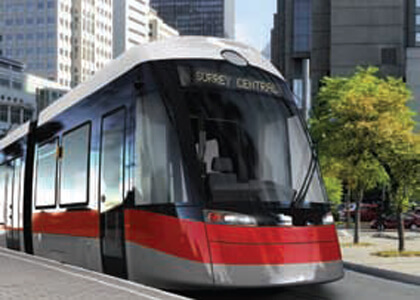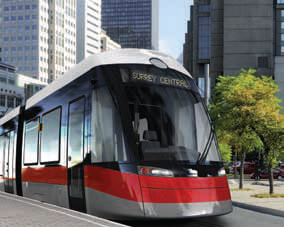The future in Metro Vancouver ~ Celebrating the City

By Susan M Boyce
Consistently ranked among the world’s favourite places to live, Metro Vancouver is a metropolitan centre many aspire to emulate. Blessed with a temperate climate, trend-setting architecture, and abundant outdoor recreation, Vancouver just keeps getting better.
“As a city, we’re becoming ever more refined — ‘shinier’ and more truly a cosmopolitan city of the world,” says Tracie McTavish, president of Rennie Marketing Systems. “Over the coming years, as we continue to fine tune our city plan, I believe we’re going to continue along that path, because people are always going to want to live here.”
Embracing Condo Living
Changing demographics and homebuyers expectations will play an increasingly important role in defining the housing market of future according to Peeter Wesik, president of Wesgroup Properties. And while a recent study indicating that, for the first time ever in Canada, single-person households are outpacing the number of households comprised of couples, he predicts Metro Vancouver’s acceptance of condo living as a lifestyle choice will continue driving the form our housing market focuses on.
“Young people used to buy a condo then move into a larger, single-family home to raise their family — but you can see that’s changing,” he says. “When Concord Pacific developed the old Expo site in downtown Vancouver, they put in a school which filled up immediately. Last summer, parents were sleeping outside the school overnight to make sure their children were enrolled.”
Then there’s the convenience and luxury factors. “Boomers especially want to have the luxuries they couldn’t afford while they were paying off their university loans or raising their families — things like granite counters and gourmet kitchens,” says Lynn Harrison, president of Harrison Marketing. “And while a townhouse or condo may be a bit smaller than the single-family house they’ve gotten used to, the convenience of lock’n’go living is becoming more and more desirable as a selling feature.”
While condos are getting smaller, they’re also getting more efficient. “The average condo from 10 years ago was 1,000 sq. ft. — now it’s closer to 800,” Wesik says. “We’re being forced to think about space differently, and we’re getting used to the idea that a condominium isn’t a place where you simply take the furniture out of your parents’ house and hope it fits. Furniture has to be right-sized to work in smaller units.”

Change Your Wheels
Industry insiders and analysts are virtually unanimous on one front: transit will shape our future cities and rapid transit will shape them most of all. “Rapid transit is absolutely key,” says Bill Szeto, associate vice president for new business development with Colliers International in Vancouver. “People are making a conscious decision to cut their carbon footprint, so projects located along SkyTrain and rapid transit corridors will do well.”
McTavish agrees. He points to the success of the Marine Gateway neighbourhood in South Vancouver where three of the four corners at Marine and Cambie are already scheduled for massive mixed-use residential development. Brentwood, he adds, is another one to watch. “It’s always been an under-developed neighbourhood with incredible potential. Now we’re looking at the potential for up to 12 towers — four million sq. ft. of new residential coming to the neighbourhood. That’s more than all the Concord Pacific lands in downtown Vancouver.” And if plans under discussion become reality, one of those towers could be 70 storeys making it the highest tower this side of the Rockies — eight floors higher than the famous Shangri-La in Vancouver. All that in addition to a planned 1.2 million sq. ft. of world-class retail.
Tsur Sommerville, PhD and well-known industry analyst from the UBC Sauder School of Business, does note, however, that density around transit nodes could be viewed as a classic ‘chicken and egg’ conundrum. “It’s actually difficult to fully separate whether development near transit nodes happens because people want to live there, or whether people live there because that’s where development is allowed to happen,” he says. Still, he stresses that as transit becomes increasingly reliable, fast, and cost effective, more people will use it.

Vancouver will always be a top ranked city.
Tracie McTavish, Rennie Marketing Systems
Transit Value Equation
Whether transit nodes are the chicken or the egg, there’s no denying they represent emerging value. Nick Belmar, Onni’s vice president of sales, says that in a recently commission study areas surrounding recent light rapid transit saw values jump up to three times more than 10 per cent increase he’d expected. “For example, during the months leading up to the completion of the Canada Line, values along the Cambie Corridor rose 19 per cent. But the real surprise was that prices then climbed an additional 14 per cent in the first half of 2010 — after the Canada Line was completed. That’s an overall, 33 per cent increase.”
Richmond also saw the same type of two-phase price increase. “Values increased 15 per cent during the two quarters immediately preceding completion of the Canada Line,” Belmar says. “Then, after a brief plateau, average resale values rose by an additional six per cent in 2009/10. These numbers prove it’s not just emotional hype. When transit came to town prices went up, stayed up, and continued rising — which is good news for buyers whether they’re short-term investors or homeowners planning to be there for the long haul.
Clearly, this is part of the same thinking that’s propelling sales in the Burquitlam area where the long awaited Evergreen Line will soon simplify life for people who commute to downtown. In fact, many industry analysts and insiders predict this neighbourhood, located on the Burnaby/Coquitlam border just north of Lougheed, is poised for growth comparable to Metrotown’s meteoric expansion. Howard Steiss, president of Red Dot Real Estate Marketing, is one of them.
“I believe in the future, distance will be measured in minutes not kilometers,” Steiss says. “Proximity to the Evergreen Line will aid in reducing consumption of fossil fuels, reduce air pollution, and lessen road congestion. But most importantly, it will save time and money for the thousands of people who live here because it will make commuting to all points in the TransLink system a breeze.” Only time will tell if this form of measurement will be applied to the hotly debated B-Line along Broadway to UBC or to a link between South Surrey and Vancouver. Many believe that while both are needed equally, they are simply too different in nature to be compared. Already one of the most used transit lines in the country, the B-Line is supported by significant existing population and daily demand from the students and staff attending UBC, so there’s no question a light rapid transit connection would be used. On the other hand, some argue that a link south through the Surrey Corridor would allow planners to develop residential hubs around new stations, thus maximizing future potential ridership. Another factor in the question of how people will get around in the future Metro Vancouver is the car co-op, an alternative that’s expected to continue ascending the popularity ladder as developers hone in on innovative way increase affordability by reducing or, in some cases, eliminating onsite parking for private vehicles. Michael Geller, president of The Geller Group, notes it’s a matter of achieving critical mass: the more municipalities and developments that participate, the more cost effective it becomes for consumers to rely on alternatives like Car2Go or Zipcar. And since owning a vehicle typically equates to having a monthly car payment, there’s direct impact on the mortgage amount a homebuyer qualifies for. Translation: ditch even one car, qualify for a higher mortgage.

I believe in the future, distance will be measured in minutes not kilometers.
Howard Steiss, Red Dot Real Estate Marketing
A Great Place to Live: Now and in the Future
Will Metro Vancouver retain its allure over the long haul? Experts say enthusiastic “yes.”
“We live in the one of the world’s most beautiful, most livable regions — and that’s not just my bias but is confirmed by experts all around the globe,” says Mark Belling, president of Fifth Ave Real Estate Marketing.
“Vancouver will always be a top ranked city,” McTavish says. “Even with our affordability challenges, we’ve built a great brand that people want be part of. We’re also safe. 2008 was a test of our resilience, and we showed the world that we were able to bounce back very rapidly.”
And while it was said many years ago, words from business maverick Joe Segal seem particularly apropos in the dynamic, ever-changing fabric of Metro Vancouver’s housing market. “Remember the past but don’t dwell on the past, live the present, seize opportunity, and look forward to the future.”
Source: New Condo Guide’s 2013 Builder & Developer Annual
Original article: The Province
Read original aricle here.
